Two little Star Trek gems entered my life recently:
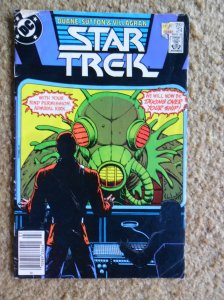
The comic book, circa 1986, is a quick and funny little story, about how Kirk and crew outsmart a group of aliens who invade the Enterprise. In command of the Excelsior, Kirk teaches Saavik a little something about humor and hunches, and we get to meet Lt. Naraht the Horta. Comics is the perfect medium for this kind of story, as it’s too light and fluffy to survive being a filmed tv episode. Not exactly canon, DC did this series of comics in the mid 80’s, to follow the crew of the Enterprise after Star Trek II: The Wrath of Khan. But I coulda told you that just by looking at the cover art and flipping through the comic book.
One of the many things I enjoy about the lifespan of Star Trek is what I like to call art-direction-dating. Similar to carbon dating, the use of Star Trek art-direction-dating allows a fan to date an image, screen shot, film credits intro and uniform by the style of title font, and by Kirk’s hairstyle.
But mostly by Kirk’s hairstyle.
See how his hairstyle goes from late 60’s blonde-ish straight-ish hair with a side part, to 80’s more brown than blonde and curly on top, and then to a 90’s whatever moptop/toupee thing.

See what I mean? can totally date everything by the hair.
Piece of pie to date the comic to mid 80s.
moving on . . . to the second Star Trek goodie.
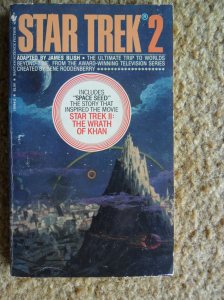
Some Trekkie* I am, I didn’t know until I was doing research for this blog post that James Blish adapted nearly every TOS episode into a short story. Working from drafted scripts that often differed from the final filmed episodes, volumes of the short stories were published between 1968 and 1975 (exactly which were written by Blish, and which were ghostwritten by his wife is another story), with each “episode” ending up as a 10-18 page short story. Perfect for quick consumption!
A few months before Abrams’ Into Darkness comes out, I found a copy of Star Trek 2 (not to be confused with the movie, Star Trek II), by James Blish. Double win: it’s got a bunch of sweet adaptations from the first season of the show, AND the famous adaptation of Space Seed, in which we first meet Khan Noonien Signh. Star Trek II: The Wrath of Khan is one of my all-time favorite movies, but who knows if I ever saw the famous episode as a child, watching out of order Star Trek reruns in syndication?
Even though Space Seed is the last entry in this Blish Volume, it’s what I’m going to talk about first, since we all really do love a villain, and Khan is pretty much the ultimate villain.
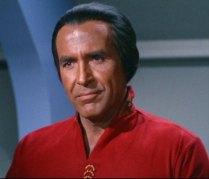 Space Seed begins with the Enterprise getting an SOS in Morse Code from a derelict ship, the Botany Bay. An away mission beams to the derelict, to find life support units onboard, and ship historian McGivers identifies it as a sleeper ship. They take the still unconscious leader back to sickbay, Kirk begins to research this ship from the 1990s. And finds nothing. Kirk and McCoy question the man who’s been asleep for over 200 years, and he quickly outsmarts them, but finally does give up at least his name, as Sibahl Khan Noonien (I typed it exactly as seen in the book. Changed before filming?). Over dinner, the command staff gently grills Khan about where he came from and how he came to be on a sleeper ship that has veered wildly off course, and Spock uses sarcasm and expectations of logic to his advantage, successfully confusing and irritating Khan. We learn that Khan is a relic of Eugenics Wars of the 1990s, that he was a warlord who escaped in exile, taking his most trusted men and women with him. Khan earns Kirk’s trust, and then betrays it by attempting to take over the Enterprise. It’s against everything Kirk believes in to take a life, but what can be done with Khan? He can’t be put back to sleep, he can’t be re-educated, he can’t be killed. Nothing to do, but put him back in exile, albeit a different exile than the sleeper ship. Milton is referenced, and the rest is franchise history.
Space Seed begins with the Enterprise getting an SOS in Morse Code from a derelict ship, the Botany Bay. An away mission beams to the derelict, to find life support units onboard, and ship historian McGivers identifies it as a sleeper ship. They take the still unconscious leader back to sickbay, Kirk begins to research this ship from the 1990s. And finds nothing. Kirk and McCoy question the man who’s been asleep for over 200 years, and he quickly outsmarts them, but finally does give up at least his name, as Sibahl Khan Noonien (I typed it exactly as seen in the book. Changed before filming?). Over dinner, the command staff gently grills Khan about where he came from and how he came to be on a sleeper ship that has veered wildly off course, and Spock uses sarcasm and expectations of logic to his advantage, successfully confusing and irritating Khan. We learn that Khan is a relic of Eugenics Wars of the 1990s, that he was a warlord who escaped in exile, taking his most trusted men and women with him. Khan earns Kirk’s trust, and then betrays it by attempting to take over the Enterprise. It’s against everything Kirk believes in to take a life, but what can be done with Khan? He can’t be put back to sleep, he can’t be re-educated, he can’t be killed. Nothing to do, but put him back in exile, albeit a different exile than the sleeper ship. Milton is referenced, and the rest is franchise history.
Also included in Star Trek 2:
Arena – While chasing an enemy ship, the Enterprise finds itself surrounded by an advanced alien species, the Metrons, who transport Kirk and the enemy leader to a planetoid to fight to the death, using only what they can find on the planetoid. The winner will be allowed to escape, and the loser will be destroyed along with their crew. As Kirk and the Gorn stalk each other, Kirk uses the few resources at hand to outsmart and outfight the larger, faster, and stronger Gorn. Kirk does win (or the series would be over, right?), and convinces the Metron to be more merciful. Kirk is transported back to the Enterprise, where has a hard time explaining exactly what just happened.
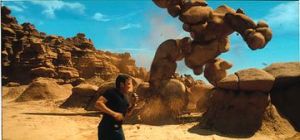
Look around, can you form some sort of rudimentary lathe?
A Taste for Armageddon – The Enterprise is escorting Ambassador Fox to conduct peace talks on Eminiar VII. The people of Eminiar have been at war with a neighboring planet, Vendikar, for hundreds of years. But no signs of war are present, cities aren’t bombed, there is no war industry, the planet appears to be perfectly at peace. When it’s discovered how this war is actually waged, Kirk and his crew are disgusted, and decide to give the Eminarians a taste of their own medicine, a taste of armageddon.
Tomorrow is Yesterday – The Enterprise comes too close to a Black Star (a black hole?) and is thrown through time, ending up orbiting Earth during 1970. The military assumes the Enterprise is a UFO, and fighter pilot Captain John Christopher begins shooting at her. He’s beamed aboard in an attempt to save his life. To put the man at his ease, Kirk shows him around the ship, and tells the truth, that they are visitors from the future, in need of a way home. But how to get Captain Christopher to keep their secret? They’ve no choice but to swear him to secrecy and send him back to Earth, as Christopher’s yet unborn child will be responsible for the space program that evolves into Starfleet’s past. Now, how to get The Enterprise back to her time? The same way it was done at the end of Star Trek IV, of course!
Errand of Mercy – The Federation and the Klingon empire are fighting over the planet Organia. The planet has no useful resources or precious metals, but its prime location makes it a perfect base, for whoever can hold it. Kirk and Spock find themselves in the center of a Klingon invasion, and while Kirk is able to blend in with the human looking population, Spock poses as a Vulcan trader. The population of Organia doesn’t resist the Klingons in any way, and in fact doesn’t seem to be the bit bothered by an invasion force that demands complete submission. We get some interesting insights into the Klingon mindset, and some descriptions of that race which I think were retconned later to be more politically correct. The story features some excellent banter between Kirk and Spock, and ends with a nice surprise.
Court Martial – the only story I didn’t much care for, Kirk is court martialed for the death of Officer Finney, who was killed onboard the Enterprise during an ion storm. A heavily character centered detective piece, this one felt like filler, after all the “exploring new worlds and new civilizations” that I’ve come to enjoy and expect.
Operation Annihilate – a plague of insanity is spreading through the galaxy, and The Enterprise finds themselves orbiting Deneva, a planet recently taken over by the plague. It’s discovered that the insanity is caused by a tentacle shaped parasite that attaches itself to the humanoids. Spock is infected, but through his powerful logic he is mostly able to defend himself against the parasite. Through trial and error and nearly putting Spock’s life at risk, they learn how the parasite works and how to destroy it.
The City on the Edge of Forever – This script was originally written by Harlan Ellison, and then changed for the filming, and Blish states that he tried to find balance between the two scripts. This episode would later win a Hugo for Best Dramatic Presentation. After an accidental medication overdose induces intense paranoia, McCoy beams himself to the planet below. Kirk mounts a rescue mission, and along with the command crew, they beam down to a cold planet covered in ruins. Spoken to by a voice who identifies itself as The Guardian of Forever, they are shown a time portal. If they can go through time and find McCoy, they can save his life. Kirk and Spock go through the portal, and find themselves in New York City during the great depression. McCoy, being a doctor, is set to save a specific person’s life. But if she lives, history will be changed forever, having a detrimental effect on the future of the United States.
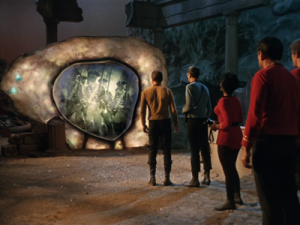
The Time Portal
Like my experience with original Doctor Who episode novelizations, I find I like these short story novelizations better than the filmed episodes. Sure, the episodes are longer and have much more characterization, but with these stories my imagination can take over – I’m not limited to the cheap special effects that were available in the 1960s.
* I never considered myself a Trekkie until JJ Abrams started making his new movies. My trekkieness is more for nostalgia rather than shiny. Abrams owes a LOT to Carey Wilber and Gene Coon, the guys who wrote the original script for Space Seed. Without that script. . . Wrath of Khan wouldn’t have existed, Into Darkness would have had a completely different story line.
Filed under: Star Trek Tagged: books, comics, James T. Kirk, movies, Star Trek 











